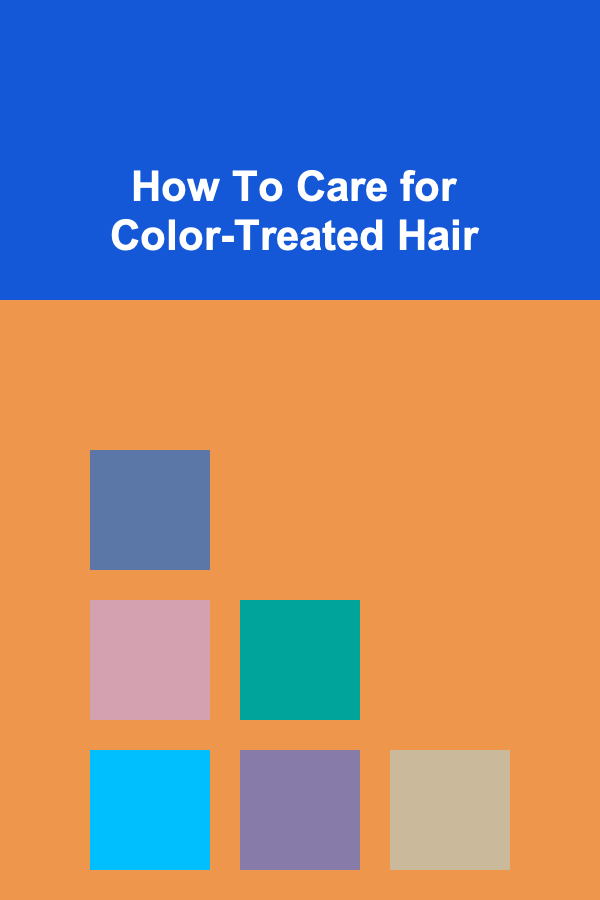
How To Care for Color-Treated Hair
ebook include PDF & Audio bundle (Micro Guide)
$12.99$7.99
Limited Time Offer! Order within the next:

Color-treated hair, whether it's blonde, brunette, red, or a bold, vibrant hue, requires special care to maintain its health and vibrancy. The process of coloring hair, whether at home or in a salon, involves chemical treatments that alter the natural structure of the hair. This can lead to dryness, breakage, and fading if proper aftercare is not followed. In this comprehensive guide, we will explore how to properly care for color-treated hair to ensure it remains healthy, vibrant, and shiny.
Understanding the Impact of Hair Dye on Your Hair
Before diving into the specifics of caring for color-treated hair, it's important to understand what happens to the hair during the coloring process. When hair is dyed, the cuticle (the outer layer of the hair) is lifted to allow the color to penetrate the cortex, which is the inner layer of the hair. This process causes the hair to become more porous, meaning it can absorb moisture, but it can also lose moisture more quickly.
The chemicals used in hair dye, such as ammonia and peroxide, can strip the hair of its natural oils, leaving it drier and more prone to damage. Additionally, some dyes contain harsh chemicals that can weaken the hair shaft, leading to breakage and split ends if not properly cared for. With this in mind, the goal of post-color care is to restore moisture, prevent damage, and protect the color from fading.
Choosing the Right Shampoo and Conditioner
One of the most important steps in caring for color-treated hair is selecting the right shampoo and conditioner. The products you use can either help or hinder your hair's health, so it's crucial to choose formulas designed specifically for color-treated hair.
Sulfate-Free Shampoos
Sulfates are cleansing agents commonly found in many shampoos, which work by stripping oils and impurities from the hair. While this can leave your hair feeling fresh, it can also strip away the color molecules, leading to quicker color fading. To preserve your color, opt for sulfate-free shampoos. These shampoos are gentle on your hair and help maintain moisture without compromising the vibrancy of your color.
Color-Safe Conditioners
Conditioning your hair is just as important as washing it. After dyeing, hair tends to become more porous and prone to dryness. A color-safe conditioner helps lock in moisture, smooths the cuticle, and reduces frizz. Look for conditioners that contain nourishing ingredients like shea butter, argan oil, or keratin. These ingredients help to strengthen the hair, repair damage, and prevent color from fading.
Deep Conditioning Treatments
In addition to regular shampooing and conditioning, incorporating deep conditioning treatments into your hair care routine is essential. Deep conditioners penetrate the hair shaft more effectively than regular conditioners, providing intense hydration and nourishment. Aim to use a deep conditioner once a week or more if your hair feels particularly dry or damaged. There are also hair masks specifically formulated for color-treated hair, which can restore shine and prevent breakage.
Protecting Your Hair from Heat Damage
Heat styling tools, such as blow dryers, flat irons, and curling irons, can cause additional damage to color-treated hair, making it more prone to dryness and breakage. To minimize heat damage, follow these tips:
Use a Heat Protectant
Before using any heat styling tool, always apply a heat protectant spray or serum. These products create a protective barrier around the hair shaft, preventing moisture loss and reducing the impact of heat. Look for products that are specifically designed for color-treated hair, as they often contain additional ingredients that help preserve color.
Opt for Lower Heat Settings
Whenever possible, reduce the heat setting on your styling tools. High temperatures can cause the cuticle to open up further, leading to color fading and damage. Instead, use the lowest heat setting that still allows you to achieve your desired style.
Limit Heat Styling
While it's tempting to use heat styling tools every day, overuse can lead to significant damage. Try to limit heat styling to a few times a week, and embrace natural hairstyles whenever possible. This will give your hair a break from the constant stress of high temperatures.
Protecting Your Hair from the Sun and Environmental Factors
UV rays, pollution, and environmental stressors can also contribute to the fading and damage of color-treated hair. Just like your skin, your hair needs protection from the sun and harmful environmental factors.
Wear a Hat or Scarf
To protect your hair from UV rays, consider wearing a wide-brimmed hat or scarf when you're outdoors. This will shield your hair from direct sunlight, which can cause the color to fade more quickly. A hat also prevents exposure to environmental pollutants, which can leave your hair looking dull and lifeless.
UV Protectant Sprays
There are sprays available that offer UV protection for hair. These products create a barrier against the sun's harmful rays, preserving your color and preventing your hair from becoming dry and brittle. Apply a UV protectant spray to your hair before heading outside, especially if you plan on spending an extended amount of time in the sun.
Avoid Chlorine and Saltwater
Chlorine in swimming pools and saltwater from the ocean can strip your hair of moisture and lead to color fading. If you swim regularly, consider wearing a swim cap to protect your hair, or rinse your hair thoroughly with fresh water before entering the pool or ocean. After swimming, make sure to shampoo and condition your hair to restore moisture.
Regular Trims and Maintenance
Color-treated hair requires regular maintenance to keep it looking its best. One of the most important aspects of maintaining healthy, vibrant color-treated hair is getting regular trims.
Trim Split Ends
Split ends can cause hair to look frizzy and unhealthy, and they can also contribute to further breakage. Regular trims, every 6-8 weeks, help to keep your hair looking fresh and prevent split ends from traveling up the hair shaft. Trimming the hair also removes any dry, damaged sections that may have been caused by the coloring process.
Maintain Your Roots
When coloring your hair, your roots will inevitably grow out, leading to a noticeable contrast between your natural color and the dyed sections. To keep your color looking seamless, touch up your roots every 4-6 weeks, depending on how fast your hair grows. Many at-home root touch-up products are available, or you can visit a salon for professional root coloring.
Nourish Your Hair from the Inside Out
Hair health doesn't just depend on external treatments. To truly maintain healthy, vibrant color-treated hair, it's essential to nourish your hair from the inside out.
Stay Hydrated
Drinking plenty of water is crucial for overall hair health. Dehydration can cause your hair to become dry, brittle, and prone to breakage. Aim to drink at least 8 cups of water a day to keep your hair hydrated and healthy.
Eat a Balanced Diet
A healthy diet full of vitamins and minerals is vital for maintaining the health of your hair. Incorporate foods rich in vitamins A, C, D, E, and B-complex, as well as omega-3 fatty acids, zinc, and biotin. These nutrients help promote hair growth, prevent hair loss, and keep your hair shiny and strong. Consider adding foods like leafy greens, eggs, nuts, seeds, and fish to your diet for optimal hair health.
Hair Supplements
If you feel that your diet isn't providing enough essential nutrients for your hair, you might consider taking hair supplements. There are a variety of supplements designed to support hair health, including biotin, collagen, and omega-3 supplements. However, always consult a healthcare provider before adding any new supplements to your routine.
Avoid Over-Washing Your Hair
One common mistake people with color-treated hair make is washing their hair too frequently. Over-washing strips your hair of its natural oils, leading to dryness and color fading. To preserve the health of your hair and color, aim to wash your hair no more than 2-3 times a week.
Dry Shampoo
In between washes, dry shampoo is a great way to refresh your hair and absorb excess oil. Dry shampoo helps to extend the time between washes, reducing the frequency of washing while maintaining the appearance of clean hair. It's an especially great option if you're looking to preserve your color while keeping your hair looking fresh.
Be Mindful of Chemical Treatments
If you're undergoing other chemical treatments, such as perms, relaxers, or keratin treatments, be cautious when combining these with hair coloring. These treatments can further stress your hair, leading to increased damage and dryness.
Avoid Overprocessing
If you plan on getting a perm or relaxing treatment, wait at least two weeks after coloring your hair to prevent overprocessing. Overlapping chemical treatments can compromise the integrity of your hair, leaving it fragile and prone to breakage.
Conclusion
Color-treated hair requires special care and attention to ensure that it stays healthy, vibrant, and strong. By following a proper hair care routine, using the right products, protecting your hair from heat and environmental factors, and nourishing it from the inside, you can maintain the health and beauty of your color-treated hair. With the right steps, you can enjoy your new color for longer, and keep your hair looking its best.
Reading More From Our Other Websites
- [Home Maintenance 101] How to Prevent and Repair Cracked Tile in Your Home
- [Polymer Clay Modeling Tip 101] Common Mistakes New Polymer Clay Crafters Make---and How to Avoid Them
- [Biking 101] Best Men's Bikes for Beginners: Finding the Perfect Ride
- [Personal Finance Management 101] How to Save Money When You're Broke: Simple Strategies to Build Wealth
- [Personal Investment 101] How to Diversify Your Investment Portfolio Effectively
- [Organization Tip 101] How to Transform Your Space with Smart Storage Solutions
- [Organization Tip 101] DIY Wood Rot Repair: Tools and Products You Need to Get the Job Done
- [Home Pet Care 101] How to Train Your Pet Using Positive Reinforcement Techniques
- [Ziplining Tip 101] Best Zipline Parks for Instagram‑Worthy Photos & Videos
- [Personal Investment 101] Building and Selling Deep Learning Models: A Guide to Making Money

How to Maintain Your Home's Electrical Outlets and Switches
Read More
How to Maintain Your Home's Garage Door for Smooth Operation
Read More
How to Optimize Space in Your Home with Modular Furniture
Read More
How to Save Money on Home Insurance for Your Rental Property
Read More
How to Set Up an Online Store for Your Small Goods Business
Read More
What Are the Benefits of Decluttering Before Organizing?
Read MoreOther Products

How to Maintain Your Home's Electrical Outlets and Switches
Read More
How to Maintain Your Home's Garage Door for Smooth Operation
Read More
How to Optimize Space in Your Home with Modular Furniture
Read More
How to Save Money on Home Insurance for Your Rental Property
Read More
How to Set Up an Online Store for Your Small Goods Business
Read More